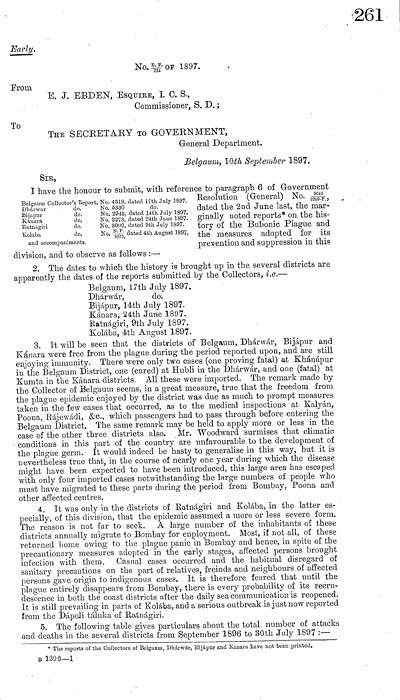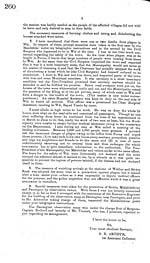Medicine - Disease > Account of plague administration in the Bombay Presidency from September 1896 till May 1897
(275) Page 261
Download files
Individual page:
Thumbnail gallery: Grid view | List view

Early.
No.B.P./224 OF 1897.
From
E. J. EBDEN, ESQUIRE, I. C. S.,
Commissioner, S. D.;
To
THE SECRETARY TO GOVERNMENT,
General Department.
Belgaum, 10th September 1897.
SIR,
Belgaum Collector's Report, No. 4319, dated 17th July 1897.
Dhrwar do. No. 5330 do.
Bijapur do. No. 2943, dated 14th July 1897.
Knara do. No. 2273, dated 24th June 1897.
Ratugiri do. No. 3000, dated 9th July 1897.
Kolba do. No.B.P./1075, dated 4th August 1897,
and accompaniments.
I have the honour to submit, with reference to paragraph 6 of Government
Resolution (General) No. 3045/2269-P.,
dated the 2nd June last, the mar-
ginally noted reports* on the his-
tory of the Bubonic Plague and
the measures adopted for its
prevention and suppression in this
division, and to observe as follows:-
2. The dates to which the history is brought up in the several districts are
apparently the dates of the reports submitted by the Collectors, i.e.-
Belgaum, 17th July 1897.
Dhrwr, do.
Bijpur, 14th July 1897.
Knara, 24th June 1897.
Ratngiri, 9th July 1897.
Kolba, 4th August 1897.
3. It will be seen that the districts of Belgaum, Dhrwr, Bijpur and
Knara were free from the plague during the period reported upon, and are still
enjoying immunity. There were only two cases (one proving fatal) at Khnpur
in the Belgaum District, one (cured) at Hubli in the Dhrwr, and one (fatal) at
Kumta in the Knara districts. All these were imported. The remark made by
the Collector of Belgaum seems, in a great measure, true that the freedom from
the plague epidemic enjoyed by the district was due as much to prompt measures
taken in the few cases that occurred, as to the medical inspections at Kalyn,
Poona, Rjewdi, &c., which passengers had to pass through before entering the
Belgaum District. The same remark may be held to apply more or less in the
case of the other three districts also. Mr. Woodward surmises that climatic
conditions in this part of the country are unfavourable to the development of
the plague germ. It would indeed be hasty to generalise in this way, but it is
nevertheless true that, in the course of nearly one year during which the disease
might have been expected to have been introduced, this large area has escaped
with only four imported cases notwithstanding the large numbers of people who
must have migrated to these parts during the period from Bombay, Poona and
other affected centres.
4. It was only in the districts of Ratngiri and Kolba, in the latter es-
pecially, of this division, that the epidemic assumed a more or less severe form.
The reason is not far to seek. A large number of the inhabitants of these
districts annually migrate to Bombay for enployment. Most, if not all, of these
returned home owing to the plague panic in Bombay and hence, in spite of the
precautionary measures adopted in the early stages, affected persons brought
infection with them. Casual cases occurred and the habitual disregard of
sanitary precautions on the part of relatives, freinds and neighbours of affected
persons gave origin to indigenous cases. It is therefore feared that until the
plague entirely disappears from Bombay, there is every probability of its recru-
descence in both the coast districts after the daily sea communication is reopened.
It is still prevailing in parts of Kolba, and a serious outbreak is just now reported
from the Dpoli tluka of Ratngiri.
5. The following table gives particulars about the total number of attacks
and deaths in the several districts from September 1896 to 30th July 1897:-
* The reports of the Collectors of Belgaum, Dhrwr, Bijpur and Knara have not been printed.
B 1396-1
No.B.P./224 OF 1897.
From
E. J. EBDEN, ESQUIRE, I. C. S.,
Commissioner, S. D.;
To
THE SECRETARY TO GOVERNMENT,
General Department.
Belgaum, 10th September 1897.
SIR,
Belgaum Collector's Report, No. 4319, dated 17th July 1897.
Dhrwar do. No. 5330 do.
Bijapur do. No. 2943, dated 14th July 1897.
Knara do. No. 2273, dated 24th June 1897.
Ratugiri do. No. 3000, dated 9th July 1897.
Kolba do. No.B.P./1075, dated 4th August 1897,
and accompaniments.
I have the honour to submit, with reference to paragraph 6 of Government
Resolution (General) No. 3045/2269-P.,
dated the 2nd June last, the mar-
ginally noted reports* on the his-
tory of the Bubonic Plague and
the measures adopted for its
prevention and suppression in this
division, and to observe as follows:-
2. The dates to which the history is brought up in the several districts are
apparently the dates of the reports submitted by the Collectors, i.e.-
Belgaum, 17th July 1897.
Dhrwr, do.
Bijpur, 14th July 1897.
Knara, 24th June 1897.
Ratngiri, 9th July 1897.
Kolba, 4th August 1897.
3. It will be seen that the districts of Belgaum, Dhrwr, Bijpur and
Knara were free from the plague during the period reported upon, and are still
enjoying immunity. There were only two cases (one proving fatal) at Khnpur
in the Belgaum District, one (cured) at Hubli in the Dhrwr, and one (fatal) at
Kumta in the Knara districts. All these were imported. The remark made by
the Collector of Belgaum seems, in a great measure, true that the freedom from
the plague epidemic enjoyed by the district was due as much to prompt measures
taken in the few cases that occurred, as to the medical inspections at Kalyn,
Poona, Rjewdi, &c., which passengers had to pass through before entering the
Belgaum District. The same remark may be held to apply more or less in the
case of the other three districts also. Mr. Woodward surmises that climatic
conditions in this part of the country are unfavourable to the development of
the plague germ. It would indeed be hasty to generalise in this way, but it is
nevertheless true that, in the course of nearly one year during which the disease
might have been expected to have been introduced, this large area has escaped
with only four imported cases notwithstanding the large numbers of people who
must have migrated to these parts during the period from Bombay, Poona and
other affected centres.
4. It was only in the districts of Ratngiri and Kolba, in the latter es-
pecially, of this division, that the epidemic assumed a more or less severe form.
The reason is not far to seek. A large number of the inhabitants of these
districts annually migrate to Bombay for enployment. Most, if not all, of these
returned home owing to the plague panic in Bombay and hence, in spite of the
precautionary measures adopted in the early stages, affected persons brought
infection with them. Casual cases occurred and the habitual disregard of
sanitary precautions on the part of relatives, freinds and neighbours of affected
persons gave origin to indigenous cases. It is therefore feared that until the
plague entirely disappears from Bombay, there is every probability of its recru-
descence in both the coast districts after the daily sea communication is reopened.
It is still prevailing in parts of Kolba, and a serious outbreak is just now reported
from the Dpoli tluka of Ratngiri.
5. The following table gives particulars about the total number of attacks
and deaths in the several districts from September 1896 to 30th July 1897:-
* The reports of the Collectors of Belgaum, Dhrwr, Bijpur and Knara have not been printed.
B 1396-1
Set display mode to: Large image | Zoom image | Transcription
Images and transcriptions on this page, including medium image downloads, may be used under the Creative Commons Attribution 4.0 International Licence unless otherwise stated. ![]()
| India Papers > Medicine - Disease > Account of plague administration in the Bombay Presidency from September 1896 till May 1897 > (275) Page 261 |
|---|
| Permanent URL | https://digital.nls.uk/74517560 |
|---|---|
| Description | Part III., Report by E. J. Ebden, Commissioner, S. D. |




